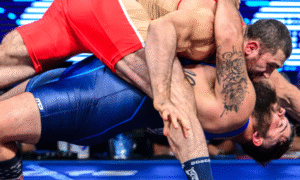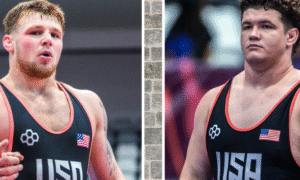Five Point Move is proud to host USA Greco-Roman National Team head coach Matt Lindland every week for Coach Lindland’s Report. For fans, coaches, and wrestlers seeking insights regarding results, training, and upcoming events, this is the place to find what you’re looking for. ALSO — if you would like to donate directly to the US Greco-Roman program, just click here. Your support is appreciated!
With what was a busy summer officially in the books and the autumn now firmly upon us, there is a lot of wrestling to get to. The first Coach Lindland’s Report in over a month includes a brisk recap of the U23 World Team Trials, which took place nearly three weeks ago. From there, the conversation pivots to G’Angelo Hancock (Sunkist, world no. 16 at 98 kg) and his move up to heavyweight. In addition, the upcoming Dave Schultz Memorial is a big topic. The event, switched to the fall for 2017, will include the new weights/weigh-in format, and that is obviously worthy of discussion. To wrap up, we cover the Midland Greco Exhibition Series and the US program’s participation with Hope Sports that saw a group of athletes build a house for a struggling family in Mexico last weekend.
5PM: There has been another World Team selected since the last time we recorded. If you would, talk about your general impressions from the U23 World Team Trials a few weeks ago. There really weren’t any “shocking” performances, but it was still interesting nonetheless.
Coach Matt Lindland: I wouldn’t say there were any big surprises in there. I think a lot of people looked at (Colin) Schubert and his past results, and he’s a very tough guy, but I’ve kind of seen (Alex) Mossing making some big moves and he has been training in our room (at the Olympic Training Center) pretty regularly, so I have gotten to see his progression and development. I really haven’t seen Schubert on a daily basis, but they were 1 and 2 seeds, so we assumed that was what it was going to be.
I was surprised by (Jesse) Porter and his performance. He’s a counter-wrestler who showed a lot of offense, but he waited until the last seconds of each match (in the finals) to show his pure offense. I wish Jesse would open up more and show what he is capable of doing because he’s a very capable athlete. He just needs to go out there and open up more, and compete like he did in the last 30 seconds of both of those matches.
I don’t think (Kamal) Bey was a big surprise, but he did have a really close match with (Alex) Meyer, the Iowa kid, that was a pretty close match. I kind of figured that (Barrett) Stanghill was our top dog at 85. And with (G’Angelo) Hancock moving up to 130, that kind of opened it up for Blake Smith, so no big surprises, at all. The biggest surprise I suppose was not seeing (Taylor) LaMont there, he was still healing up a hand injury, but he’s now healed up and ready to go.
5PM: How much time do you think it will take Hancock to assimilate into 130, grow into it more, become more comfortable at that weight?
ML: Well, if you watched the way he performed at U23’s, it looked like he was already there. That was against some of our top domestic talent but not against the top guys in the world. I think it is going to take a little bit, but it was a good opportunity for him to test the waters and see where he’s at with 130. I hope he competes at the Schultz event just to get a little more experience and matches in at that 130 weight class. They wrestle a different style and he can’t get caught trying to push with the big heavyweights. He needs to use his speed and athleticism to create angles and make those big guys move their feet. But we’re going to take him to Belarus and he’s going to have some good training partners there for a couple of weeks, so we’ll be able to get him prepared properly at 130. We’ll see what he gets up to as far as size-wise. I think he is probably walking around at only 110 kilos right now, but we can put a few pounds on him before the U23 Worlds.
5PM: This is the perfect time in his career to move up, right? He’s still young enough to where he is just going to naturally grow into his body more and more. If he was going to move up anyway later in his career, I’d guess it is better if he just does it now.
ML: Yeah, I think with 98 kilos changing to 97 and now it’s day-of (weigh-ins), that is a much bigger cut than just one kilo when you talk about performing two hours after you step off the scale. I think he doesn’t really have an option, regardless if he tries to make it another year. Between now and 2020, he’s going to grow out of that weight class. If he is going to do it, he should do it right now. And like I said, I already feel like he has grown or is going to grow out of that weight class soon enough. With the change, it’s time for him to make that move and get himself acclimated to that weight class.
5PM: The Dave Schultz Memorial next week essentially switches places with the New York AC. The biggest attraction obviously is the testing of the new two-day format and the new weights. We’ve discussed this a lot, how it’s going to change careers probably. Does this give the US guys any sort of advantage, having a sneak preview this far out from 2018?
ML: I think like you said, it’s really replacing another tournament that is usually around the same time, which is the Bill Farrell hosted by the New York Athletic Club, so it doesn’t really affect our schedule that much. It gives these guys a chance because they’ve had a break and they’re back on the mat training now. They can kind of ease themselves back into competition. This event is pretty good for that.
I actually think it’s a little unfortunate that we started the weights early because that spreads the weight classes out, and it might make the brackets a little smaller and not as strong as if there were still eight weight classes. But on the flipside of that, it gives some of the lighter-weight guys an opportunity and a spot to compete in. So I’d like to check out some of the young kids, the 55-kilo guys, and see how that weight class is going to shake out, for sure. Yeah, it’ll be interesting to see how people perform on a one-day platform.
5PM: Following Schultz, you’re taking a delegation over to Belarus for the prescription, a camp and a competition. Who is going to be a part of the trip thus far?
Coach Matt Lindland: We’re taking the top-four weight classes at the U23’s. We’ve got Kamal at 80, Stanghill at 85, (Blake) Smith, Hancock, and Kevin Radford and Pat Martinez want to tag along so they can get in a good camp in this time of year, so it was open for them to come join us. Hopefully, we can get a dual scheduled for after that first week. We’re talking about having a dual meet with the Belarusian team. I know we only have seven athletes, but I think we can work it out for a nice friendly dual meet.
5PM: You’ve got Belarus and then the next month, a trip over to St. Petersburg, Russia. With the Open not on the calendar for December, did you want to make sure you kept guys busy before the New Year? When the schedule was being worked on, was that part of this, making sure there were things to look forward to?
ML: Yes, I think that is absolutely important, especially for our younger and more inexperienced guys, get them overseas competing. We had a group of athletes leave today for Sweden and the Malar Cupen. They’ll have a nice camp over there and a competition. Some of those guys will come back right away for the St. Petersburg tournament and we’ll also send a group of Senior athletes to that event. And the week afterwards is the Haavisto Cup in Finland, so some of those guys may take that opportunity to go from St. Petersburg, catch a train, and then go over to Finland.
There are a lot of ways to make this work based on people’s budgets and what they are capable of doing, because some of these athletes are currently in school and can only miss so much time. The nice thing is that they do have a Thanksgiving break over some of these events, especially for some of the guys who are going to the U23’s. It’s just good to see a lot of our athletes getting a lot of good competitions in and there are a lot of opportunities. This time of year has always had a good number of events going on in the Nordic regions. Haparanda has always been an event, the Vantaa (Cup) has always been an event. This St. Petersburg event is something we’ve always gone to. Last year was the first year we didn’t go to it because we received the information pretty late and we already had our Open scheduled for the same time.
So yeah, this is a good time of year for guys to go get some competition and extra training in. We saw the benefits of international training really pay off for guys like Pat Smith last year and Cohlton Schultz, guys who spent multiple weeks overseas getting those training opportunities and international matches. It seems to have been the key to success for a lot of our athletes.
5PM: Two weekends ago, there was a large exhibition series put on in Nebraska by Cody Goessl along with some help from Zac Dominguez and the MWC guys. It was thrown together quickly but there was a lot of coordination with other coaches and it wound up being a pretty grand scale event. With the time of year and the age group participation, it’s even more special. What can we do to have more events like this pop up throughout the year and not just the spring/summer?
ML: I think that was a great event. It was good to see a lot of our athletes getting out there to compete. Again, after a nice break, especially for the age-group developmental athletes competing in Greco-Roman during a period in which some refer to as the folkstyle season (laughs). Having our athletes getting out there, competing, and having some fun doing Greco-Roman is important. Some of the athletes who traveled out to that event came to visit us in Colorado Springs for a few days and trained with us. Then they headed back to South Dakota.
We’re incredibly blessed to have outstanding volunteer coaches like Zac Dominguez, Terry Pack, and Lucas Steldt. We are growing those club systems and those club programs to where next year, there will be double the amount of clubs at that event, and we will continue to grow that network. The fact that there was already a women’s event going on in the same building, they had officials who were already there, and that allowed us to piggyback onto that and really start our event. We had over a hundred matches in one day, I think they were even out of the gym by two or three o’clock. That it was an exhibition really takes the pressure off of these athletes to go out there and compete, to have fun and enjoy this. Because some of them will go back into a folkstyle system where it’s just about the pressure of performing, and that kind of leads into what we did in Mexico and part of the reason why we went there, which we can talk about later.
But I think that was a crucial thing, to have it be an exhibition rather than a major competition. I think that allowed those guys to go out there to compete, have fun, and enjoy this time of year, because every athlete I talk to who does Greco-Roman, they tell me they like the style and wish they didn’t have to do the other styles. I always laugh and think, I don’t know, is somebody making you do these other styles or something? Because it’s kind of funny to hear a young guy say, I wish I didn’t have to. I tell them they don’t have to, and we’ve had a couple of guys who have made that decision to come out here, like Nick Boykin, Luis Hernandez, and even Mike Rogers, who was disappointed he chose to go the folkstyle route because it was part of the deal. He thought that was what he had to do. When you let people know they can make their own choices and their own decisions, they are surprised or something, I don’t know.
5PM: Mexico was yet another example of the USA Greco-Roman program taking time out of training and competing to engage the community and in this case, it wasn’t even the American community, it was another country. In just two days, you guys built a house. How did this experience compare to other outreach endeavors you have participated in since becoming the National coach and also, what was the biggest takeaway among the athletes from the weekend after arriving home?
Coach Matt Lindland: First of all, we did build an entire house in two days, which was just incredible, the fact that anyone can do that, and it’s a credit to Hope Sports for coordinating this and putting this on. The founder of Hope Sports is a guy who was a professional cyclist in his life. He was traveling the world seeing what we see, too — poverty and people who don’t have hope in their lives because of their situations. It’s unfortunate when you see that. You’re like, What can I do? I can’t help everybody. We were told a pretty interesting story about this time when the ocean got really high. All of the starfish washed up on the rocks, and there was this little kid just grabbing starfish and throwing them back into the ocean. An old guy then came up and said, “What are you doing? You can’t save all those!” The kid replied, “Well, I can save a few.” So that is what I am going to do.
Our idea, we thought we were going down there to serve the poor and the people who have less than we do. That does give you perspective on life, of course. But the real reason why I wanted to take our athletes down there is to have them experience this, because although we do see this when we travel, we don’t necessarily always engage with it. I remember when Joe Rau and I were in Mongolia and we took time to go out in the villages, go into people’s homes, and spend part of our day with just some of the poorest people in Mongolia. It was an incredible day, and we didn’t get a chance to serve, just spend time with them. To drink tea and have sour bread. I don’t know if you’ve ever had sour bread, but when somebody offers it to you, you just eat it and don’t really say anything, you just get it down. Luckily, we had our tea there to help us.
But for these guys who are competing, they have a lot of their identity wrapped up in who they are as an athlete and how they perform. With their identities so wrapped up in, If I win, it feels good, well, you have to continue to win to keep getting that feeling. If you don’t have a purpose-filled identity where you think of others, and your identity is only wrapped up in how you perform, there is a lot of shame when you don’t have success. I wanted these guys to understand that there is more out there than what they do. There is more meaning.
The other thought was that it doesn’t produce fear. When your identity is so wrapped up in how you perform, when you do compete, you tense up and don’t even perform up to your abilities. So I think this kind of stuff really helps change the mindset of our athletes and helps them build healthier relationships with everyone, but also with their teammates because we’re working together. We had four guys on the roof, we had four guys putting the walls up, I was working with a couple of guys building… I mean, we literally put a roof over someone’s head and changed their life forever. When they were living in a shack with the mattress on the dirt floor, when it rained the mattress would take on moisture and attract mold. It’s just an awful situation for these people to live in, so for them to have an actual floor and a roof over their head, it was a really fulfilling experience.
Be sure to follow Coach Matt Lindland on Facebook, Twitter, and his official blog for updates on the US Greco-Roman Wrestling program.
CLICK HERE TO DONATE TO THE USA GRECO-ROMAN PROGRAM
SUBSCRIBE TO THE FIVE POINT MOVE PODCAST
iTunes | Stitcher | Spreaker | Google Play Music | RSS


















